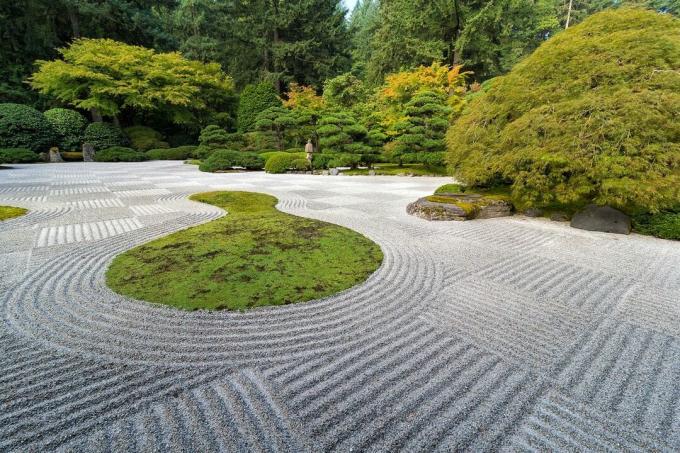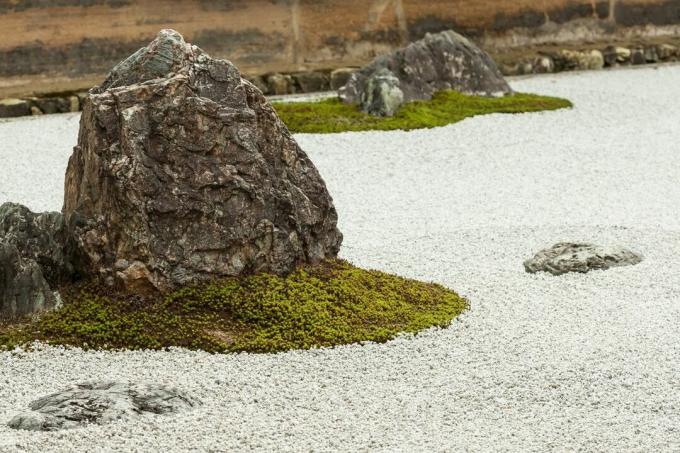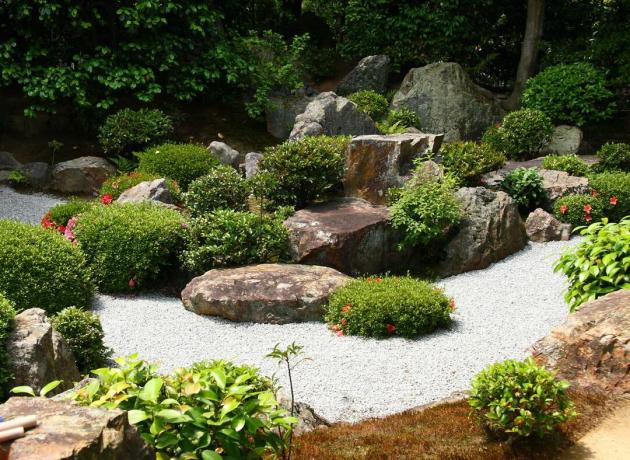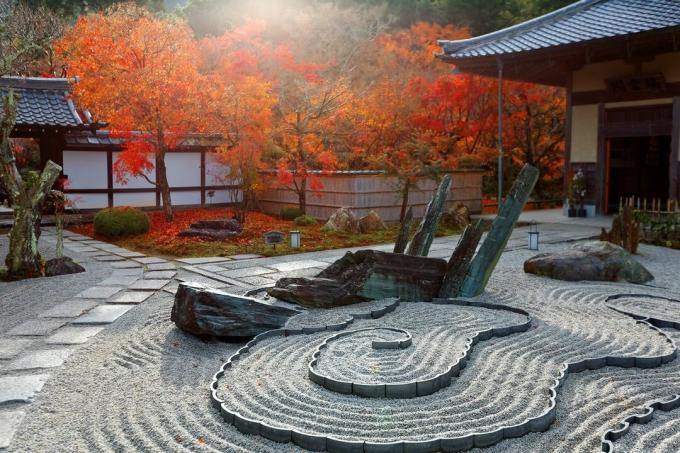Many want to create a place of rest and relaxation in their garden. We give tips on creating a zen garden that ensures inner balance.

For many, gardens represent a place of rest and relaxation. The zen garden in particular should have an exceptionally calming charisma. The Japanese garden shape is often associated with perfect harmony and aesthetics - such a garden is therefore the perfect place for mindfulness and meditation. In their homeland the gardens are called Kare-san-sui, which translates as "dry landscape" and means directly indicates the main material of the Zen garden - namely, this is one Rock garden. But in contrast to rustic German Rock gardens Zen gardens are less colorful and rely on clear lines that are ingeniously laid out. We'll tell you how you can design a Zen garden here.
contents
-
Create a zen garden
- The 3 main elements of the Zen garden
- Planning the zen garden
- Design of the zen garden
- Plants for the zen garden
- Stones in the zen garden
- Decoration in the zen garden
- Proper care of the zen garden
Create a zen garden
The Japanese Zen garden is also becoming increasingly popular in this country. Anyone looking for inner peace and a place for meditation is well advised with this form of garden design. Luckily, creating a zen garden is not difficult, so you can look forward to an aesthetic garden at home that invites you to marvel and linger.
The 3 main elements of the Zen garden
A traditional Zen garden classically consists of only three basic elements: water, stones and moss. The first point in particular regularly causes confusion, because water is rarely found in a Zen garden. In fact, this is symbolized by the large gravel areas that are typical for this form of garden design. The impression of a body of water is reinforced by flowing surfaces and patterns that are raked into the gravel. Stones, on the other hand, usually represent islands or mountains, but can also stand for groups of animals. Moss is actually the only plant that is used in a traditionally designed Zen garden. In the meantime, however, trees, especially topiary and bonsai, are often planted in Zen gardens - flowering plants, on the other hand, hardly play a role and are rarely found. The goal of the Zen garden is to use its basic elements to create an environment which represent nature and reflect the proportions of forests, mountain ranges and rivers target.

Planning the zen garden
Before you start creating a zen garden, precise planning in the form of a sketch is of crucial importance. Above all, it must be clarified whether you want to arrange your entire garden in Zen style or whether only a separate area should be redesigned. The latter method is particularly popular, in which only a small part is converted into a Zen garden and through a hedge or a fence is separated from the rest of the property.
A place that is clearly visible from the terrace or window is ideal, as looking at the Zen garden in particular conveys peace and serenity. When doing this, you should also consider the various gravel areas and the positioning of individual plants and draw stones so you can calculate the appropriate amount of materials such as gravel and sand can. Ideally, the individual surfaces should be laid out in such a way that they appear as natural as possible - that means that the transitions between the surfaces are fluid and that at first glance there is no beginning and no End sees.
Design of the zen garden
When you have completed the sketch of your zen garden, the work in the garden begins. First of all, all lawns in the area of the Zen garden must be cut off together with the roots. To do this, roughly the top 20 centimeters of the garden soil are removed. Then you put a garden fleece or another water-permeable film in the dug bed - this one later prevents grasses, weeds or other plants from making their way through the gravel layer tracks. It is not necessary to fasten the film, as it is reliably held in place by the heavy gravel. Plants such as small bonsai or moss are planted by cutting the foil in a cross shape and planting the green garden dwellers directly in the soil below. But if you don't want to damage your garden fleece, you can plant the plants in sufficiently large pots. Now the gravel can already be filled. The height of the gravel layer can vary depending on your taste - however, care should be taken to ensure that that the surface can later be raked easily without the tool damaging the film can. Finally, place stones and decorations and rake the typical patterns into the gravel to give the zen garden its characteristic appearance.

How do you design a zen garden?
1. Define floor plans and individual beds in a sketch
2. Cut the lawn about 20 cm deep
3. Line the excavated bed with water-permeable sheeting
4. Insert plants by cutting the foil in a cross shape and planting the plants in the soil below
5. Fill the bed with gravel
6. Insert stones and decorations
7. Rake gravel into shape
Plants for the zen garden
Traditionally, only one genus of plants is allowed in the Zen garden: moss. The design with mosses is not as boring as it sounds at first, because they actually have numerous variations to offer. Various native moss species such as the bearded moss (Barbula) or some species of the red moss (Polytrichum) not only convince visually, but are also particularly easy to care for. Moss substitute plants such as star moss (Sagina subulata) are especially popular in Zen gardens. With its cushion-shaped growth, this is an ideal and step-proof ground cover and is also considered particularly robust, which is why it is also suitable for partially shaded places. The Andean Cushion (Azorella trifurcata) with its rosette-like growth is suitable for the Zen garden and is a pretty eye-catcher. By combining different mosses with one another, interesting texture differences and thus unobtrusive eye-catchers can be realized in the Zen garden.

In addition to the various mosses, other plants are increasingly being cultivated in modern Zen gardens. Of particular importance here is the bonsai, i.e. the miniaturized growth form of well-known trees, which also has its origin in Japan. Cypress trees are also suitable for the Zen garden (Cupressus), but especially conifers are very popular. Pine varieties such as the Japanese black pine (Pinus thunbergii), the white pine (Pinus parviflora) or the Japanese red pine (Pinus densiflora) are welcome guests as a sign of longevity and strength. The Japanese maple is particularly eye-catching (Acer palmatum), the one with a intense autumn colors impressed. But also the Japanese yew (Taxus Cuspidata) or the Boxwood (Buxus sempervirens) can be used as a topiary. Bamboo species (Fargesia murielae), which do not form runners, are also eye-catchers thanks to their Asian charm in Zen gardens.
Stones in the zen garden
Stones have a special meaning in the Zen garden and are often even more important than plants. They often represent mountain ranges or islands symbolically and often form the focal point in the garden. However, they should never be set up symmetrically or even in geometric shapes - because the Zen garden is based on natural proportions, becomes a natural asymmetry or a wave pattern preferred. For this reason, stone groups often consist of an odd number, which are composed of a large main stone in the middle and several smaller side stones. The type of rock is usually of lesser importance and can be selected according to individual taste. However, hard rocks such as granites or basalts are particularly suitable due to their high resistance. You should commit yourself to one or two types of rock, otherwise the Zen garden quickly looks too restless. From an ecological point of view, it is recommended to use regional rock types.
tip: Erratic boulders, which can be found in many regions, can also be wonderfully accentuated in the Zen garden.
Decoration in the zen garden
Even if the classic Zen garden can do without decoration, many owners want to give their garden the finishing touch with a few works of art. In this garden, however, the motto “less is more” applies - limit yourself to a few, meaningful decorative elements in order not to disturb the clear, natural lines of the Zen garden. Stone elements, such as sculptures or lanterns, go particularly well with the style of the garden. Buddhas are also a great fit because of their Asian origins and calming charm. Bamboo articles, pagodas or water basins are not classically provided in the Zen garden, but can become great eye-catchers.

Proper care of the zen garden
Not only looking at the Zen garden is said to have a calming effect on the mind, the work in it is also considered to be almost meditative. It is really lucky that working in the Zen garden also has a positive effect on the body, because you can only enjoy your garden for a long time with regular care. Typical tasks that need to be done from time to time to maintain the garden are For example, picking up leaves and other parts of plants, sweeping the paths or plucking of weeds. Make sure that your thoughts are completely with yourself and your work - this is how the care of the Zen garden has a particularly meditative effect. Raking the gravel surfaces also has a calming effect. Here you can also live out your creative streak and draw various wavy or straight lines in the gravel. If you have decided on plants in the Zen garden, you also have to take care of them. In particular, regular pruning (at least twice a year) of the topiary is necessary to maintain the clear lines of the Zen garden. In the case of pines, the young shoots should also be cut off - this ensures that the trees remain particularly small and flat
